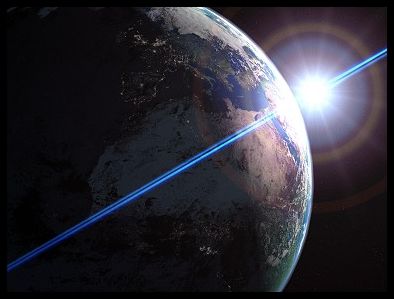Sun as white dwarf begins to slowly cool and fade away into a long night...
With no additional energy source, the Sun gradually fades to oblivion.
Ultimately, the Earth cools to a few degrees above absolute zero.
All stars will eventually share a fate similar to that of the Sun.
The Empty Empty Sky
As the Universe expands:
--Expansion continues forever at a faster rate
--Space between galaxy clusters widens
--Universe cools down at a faster rate
The "Cosmological Horizon"
--Distance beyond which we can't observe due to finite speed of light
--Nearest galaxies not bound to local group will disappear after ~1011 years
--The sky will be devoid of Galaxies
A Dying Universe
Five Ages of the Universe
Primordial Era - big bang -> 106 years
Stelliferous Era - 106 years -> 1014 years
Degenerate Era - 1014 years -> 1045 years
Black Hole Era - 1045 years -> 10100 years
Dark Era - >10100 years
Stelliferous Era: 106 years -> 1014 years
Encompasses the present day
--Star formation continues
--Only stars with M>0.8M? have had time to use up their hydrogen
Future evolution
--Star formation will eventually cease
--Low-mass stars will dominate
End of Star Formation
After t=1014 years:
Successively more matter is locked up in stellar remnants, depleting the free gas reserves.
Cycle of star birth & death is broken:
Nuclear fuel is exhausted
Red dwarfs burn out as low-mass white dwarfs
Remaining matter is locked up in black dwarfs, cold neutron stars, and black holes
The last stars fade into a long night...
The Littlest Stars
Smallest mass star capable of fusing hydrogen is ~0.08 Solar Masses
These stars have a lifetimes of 1013 years
End of Life?
Without nuclear energy generation in stars, sustaining life is more difficult
Still some hydrogen, so fusion still possible
Could 'harvest' brown dwarfs
Degenerate Era: 1014 years -> 1045 years
Dissolution of Galaxies
After t=1019 years:
Stellar remnants within galaxies interact over many many orbits.
Some stars gain energy from the interaction and ~90% get ejected from the galaxy.
After t=1024 years
Others lose energy and sink toward the center.
After t=1030 years
The last 10% of remnants coalesce into Supermassive Black Holes.
Dissolution of Matter?
After t=1032-45 years:
Some particle models predict that protons are unstable.
Protons decay into electrons, positrons, to neutrinos.
All matter not in Black Holes comes apart.
End of Life?
Without nuclear energy generation, life as we know it becomes effectively impossible
Only sources of energy are extremely weak background radiation and gravity
Would have to learn how to harvest gravitational energy
Black Hole Era: 1045 years -> 10100 years
Only black holes left
Two kinds
--Supermassive black hole in the center of the Galaxy
--Stellar-mass black holes
Evaporation of Black Holes
After t=1067 years:
--Remaining stellar-mass black holes evaporate by emitting particles via Hawking Radiation.
After t=10100 years:
--Supermassive Black Holes evaporate one-by-one.
End of the epoch of organized matter
Dark Era: >10100 years
After black holes have all evaporated:
--Universe continues to cool off toward a Radiation Temperature of absolute zero.
--Only matter is a thin, formless gas of electrons, positrons, neutrinos.
--Only radiation is a few increasingly redshifted photons.
The end is cold, dark, and disordered...
End of Life?
Everything is at the same temperature and same entropy
According to second law of thermodynamics, there are then no sources of energy
Life becomes effectively impossible.
The End
See A Note about Graphics to learn
why the graphics shown in the lectures are generally not reproduced with
these notes.
[
Return to the Astronomy 161 Main Page
|
Unit 7 Page
]
Copyright © Scott Gaudi All Rights
Reserved.

